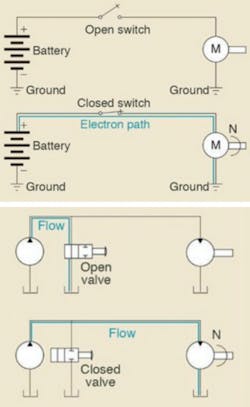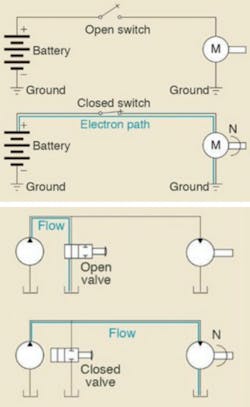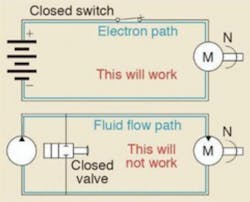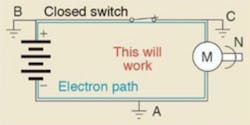How to make your car battery explode
I take exception to your article about electrical (electronic) circuits as compared to hydraulic flow in the August 2007 issue of Hydraulics & Pneumatics.
1. In Figure 1 of the article (with the OPEN switch), there is absolutely no potential applied to the motor from the battery. That is a fact. However, in the drawing below that, that with the valve open, there could still be a very slight potential on the hydraulic device. It may not be much, but could be a little. This is a difference in that if the flow of the valve is obstructed even slightly, the device could activate. In the lower portion of Figure 1, I agree that the circuits are the same, full electrical flow and full hydraulic flow.
2. To make Figure 1 more correct, you would need to change the switch in the upper left to parallel grounded and closed to make a similar circuit as upper right drawing.
3. Figures 2 and 3 are the ones that are really dangerous. Don’t believe me? Go to your truck and take a wire from the positive terminal of your battery and go to ground (engine block), then try to start truck, or even turn on the radio. Don’t really try that, it will explode your battery.
4. Figure 3, points B and C” run to ground (Chassis) will cause a fire or battery explosion.
5. This article should be further explained and corrected for your readers so that someone doesn’t wind up hurting themselves.
7. There seem to be other misconceptions in the article, but, to be honest, I got bored with reading it. Sorry.
Petey Parish
Chief Estimator
Lakeland, Fla.
[email protected]
Columnist Jack Johnson responds:
Thank you for taking the time to comment. I found your comments to be insightful as well as clarifying.
2. If I understand what you propose, that puts a dead short across the battery, an undesirable situation. See my further responses, below.
3. Oh, but I do believe you! And I agree with you that if you were to simultaneously connect all three grounds as shown in Figure 3, there would be problems with short circuits, however, in the accompanying text, which I now quote: “For example, the circuit of Figure 3 has three different ground points. Each represents an optional choice for ground location. Only one can be chosen, but it makes no difference which one.”
4. I agree, that if you connect from the positive terminal of the battery of a did not use the term chassis. I used the term ground, as in mother Earth, and I carefully made the distinction between common and mother Earth. You chose the term chassis. In other words, you missed the point, choosing to equate chassis with ground, and that is precisely the distinction that the article makes.
It is quite safe to make a connection between the positive battery terminal and mother Earth, as long as the vehicle is properly tired, giving the chassis electrical isolation from mother Earth. I urge you to re-read the text material on page 46, middle column, which takes up the subject of the difference between common (as in chassis) and mother Earth (ground).
5. Agreed. In retrospect, I wish that the qualifying statement in the text regarding only one ground being allowed had also been included in the caption of Figure 2. It would have helped to clarify the figure and the point I was making.
6. As for the credibility of the books, I will let them speak for themselves, and let those who have actually read them speak to their credibility. You should certainly not feel obligated to purchase them, but I would be pleased if you did. And I would be even more pleased to receive any feedback regarding them, good or bad. That’s how improvements are made.
7. I am sorry you were bored, however I would like to know what other misconceptions there were in the article. But, I will have to try to be more interesting in the future.
And don’t be sorry. Your comments have been helpful. They allow me to respond, and, I hope, get better in the future.




